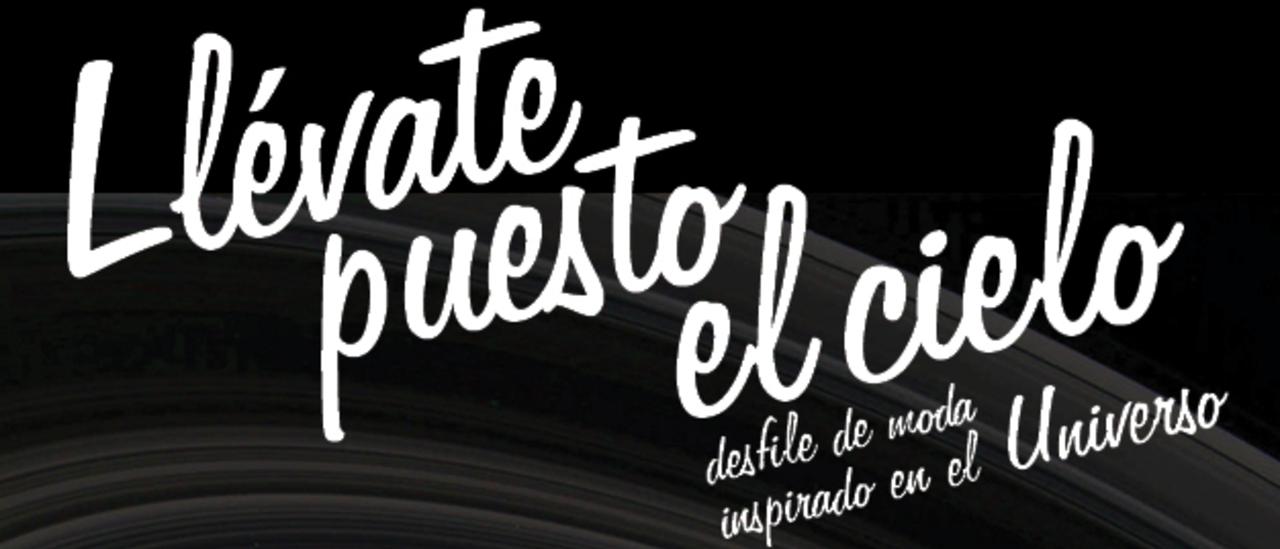Related grants:
General
The Event
Fashion is and remains a unique phenomenon of humanity. It affects not only our material culture but also our social life. Fashion is not only a manifestation of art, but also helps us to express ourselves. History is important for contemporary designers for many reasons. First, the world and society never remains the same, technology improves and our lifestyle changes. Fashion affects everyone in the world and is continuously changing, like music, books and art. All these aspects have to be considered by contemporary designers. Lifestyle and trends are strongly influenced by socio-cultural changes such as modernization, technological innovation, artistic movements and science itself. Fashion goes beyond the clothes and the way we choose to live our lives. Lifestyle is how we communicate and how we dress.
Stars, like fashion, have different shapes, sizes, colours and patterns. Therefore, the analogy between fashion and stars gives us an ideal opportunity to explain the beauty and the complex physics of stars, using expressive means (audiovisual and music) and Fashion itself, which is common to all age groups.
The Instituto de Astrofísica de Canarias (IAC) is collaborating with the School of Art and Design (SAD) “Fernando Estévez” to create an event that will consist of a fashion show inspired by Astronomy and the Cosmos. The purpose of “Cosmic Fashion” is to disseminate Astronomy through the designs created by the students of SAD “Fernando Estévez” (Ciclo Formativo de Grado Superior de Estilismo de Indumentaria and Enseñanzas Artísticas Superiores de Diseño de Moda) who have been advised by Tariq Shahbaz, research astronomer of the IAC. In this way we merge art and science, inspiring innovative creations from young designers that will be presented to the public. The project has the support of the collective Tenerife Moda, the beauty center Nuevo Stylo e Imagen, the modelling agency Quecapricho Olé, the Town Hall of San Cristóbal de La Laguna, the Ministry of Education, Universities and Sustainability of the Canary Islands, and funding from the Spanish Foundation for Science and Technology – Ministry of Economy and Finance (FECYT).
The event will take place at 21:00 on Friday 5th of June 2015 in front of Church of the Immaculate Conception, San Cristóbal de La Laguna.
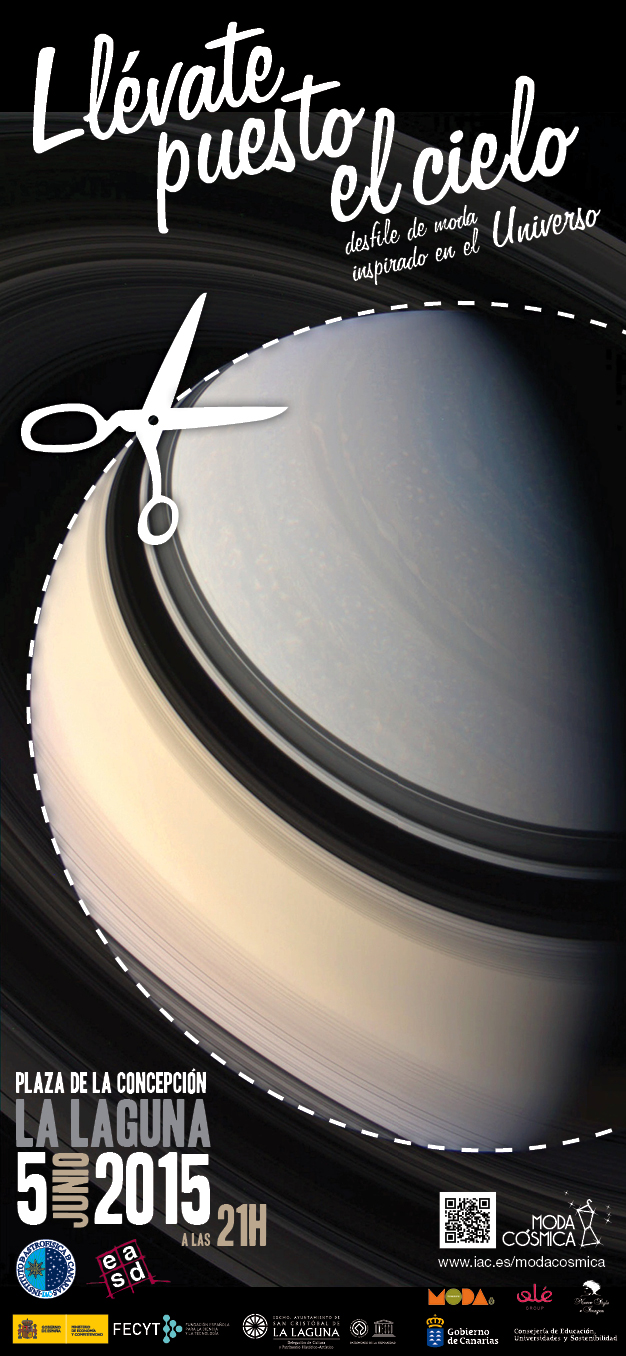
Fashion and Astronomy
COLOURS
Astronomy is full of references to colour; white dwarfs, black holes and red giants. If you look up into the night from a dark site, you may be able to see a few thousand stars. Since the stars are all very far away they appear as points in the sky. Most appear white, but a few stars such as Antares and Betelgeuse have an orange or reddish hue to them. Others stars such as Rigel suggest a more blue colour.
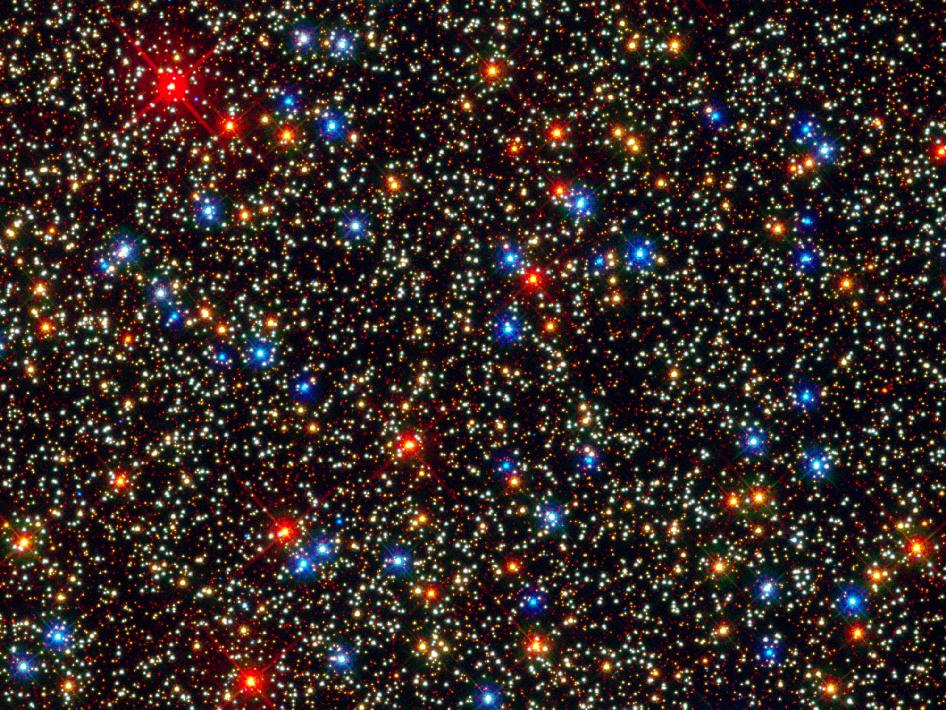
A unique place to look for stars with different colours living close to each other, is in the crowded core of a giant star cluster, Omega Centauri. It is a city with perhaps 10 million stars with different types and ages and is relatively nearby, which makes it an impressive sight. The image shown reveals stars with a variety of colours, representing the different stages of their life cycles. The majority of the stars are yellow-white, like our Sun. However, the cluster also contains many red giant stars with a sprinkling of very conspicuous blue stars. The orange dots show stars towards the end of their normal lives, whereas the red dots show stars even later in their life cycle, as they become red giants. The faint blue dots show the white dwarfs, stars in which only the burned-out cores remain. Other stars, that appear dark blue, are “blue stragglers”, older stars that have acquired a new lease of life after colliding and merging with other stars.
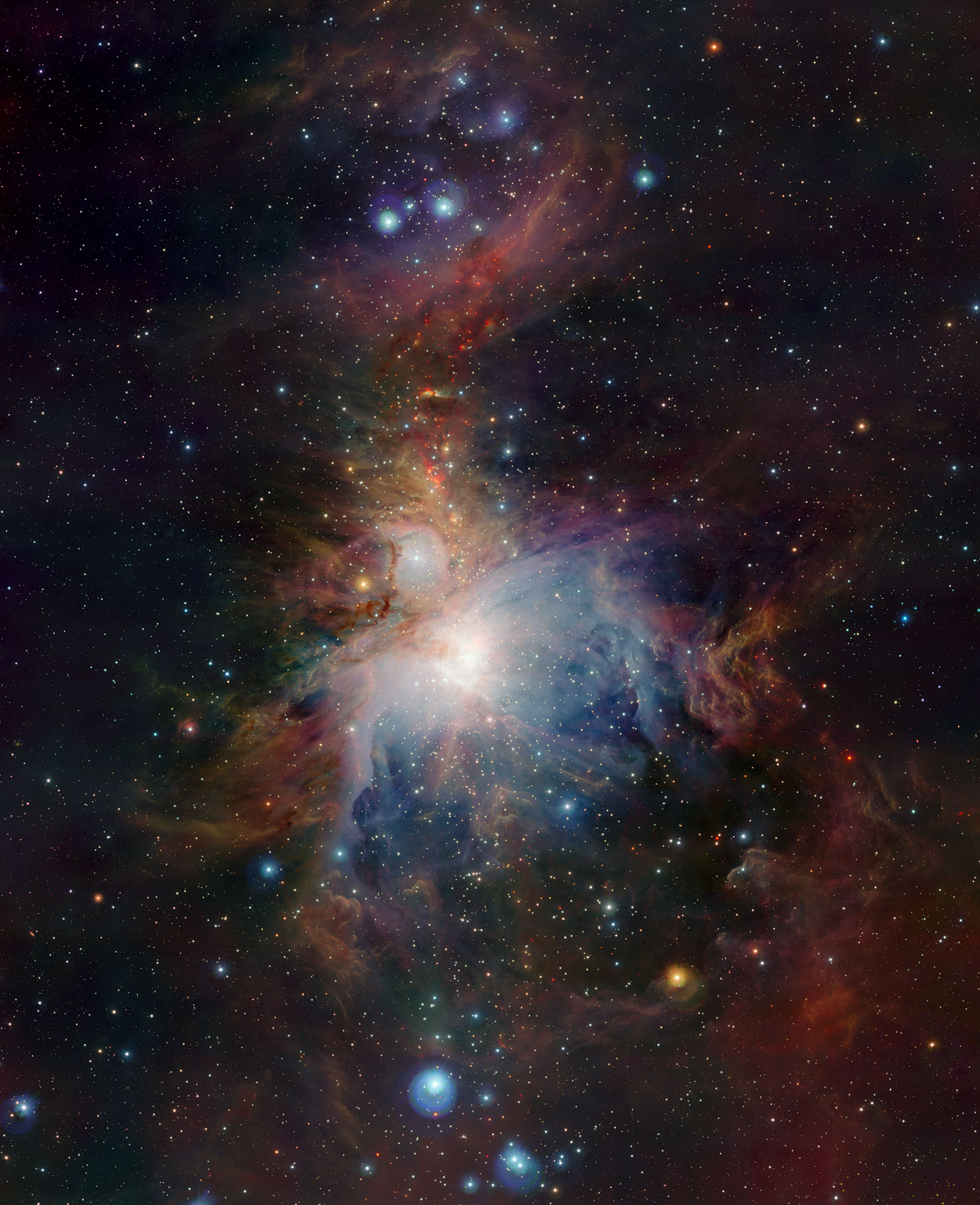
Nebulae are probably the most beautiful objects in the universe, glowing with rich colours and swirls of light. They are immense stellar nurseries where clouds of dust and gas collapse to form the next generation of stars, the basic building blocks of the Universe. The intense ultraviolet light from the newly formed stars inside these immense clouds, illuminate the nebula making it fluoresce in beautiful reds, blues and greens. These colours are the result of different elements within the nebula. Most nebulae are composed of about 90% hydrogen, 10% helium, and 0.1% heavy elements such as carbon, nitrogen, magnesium, potassium, calcium, iron. These clouds of matter are also quite large, in fact, they are among the largest objects in the galaxy. Many of them are dozens or even hundreds of light-years across.
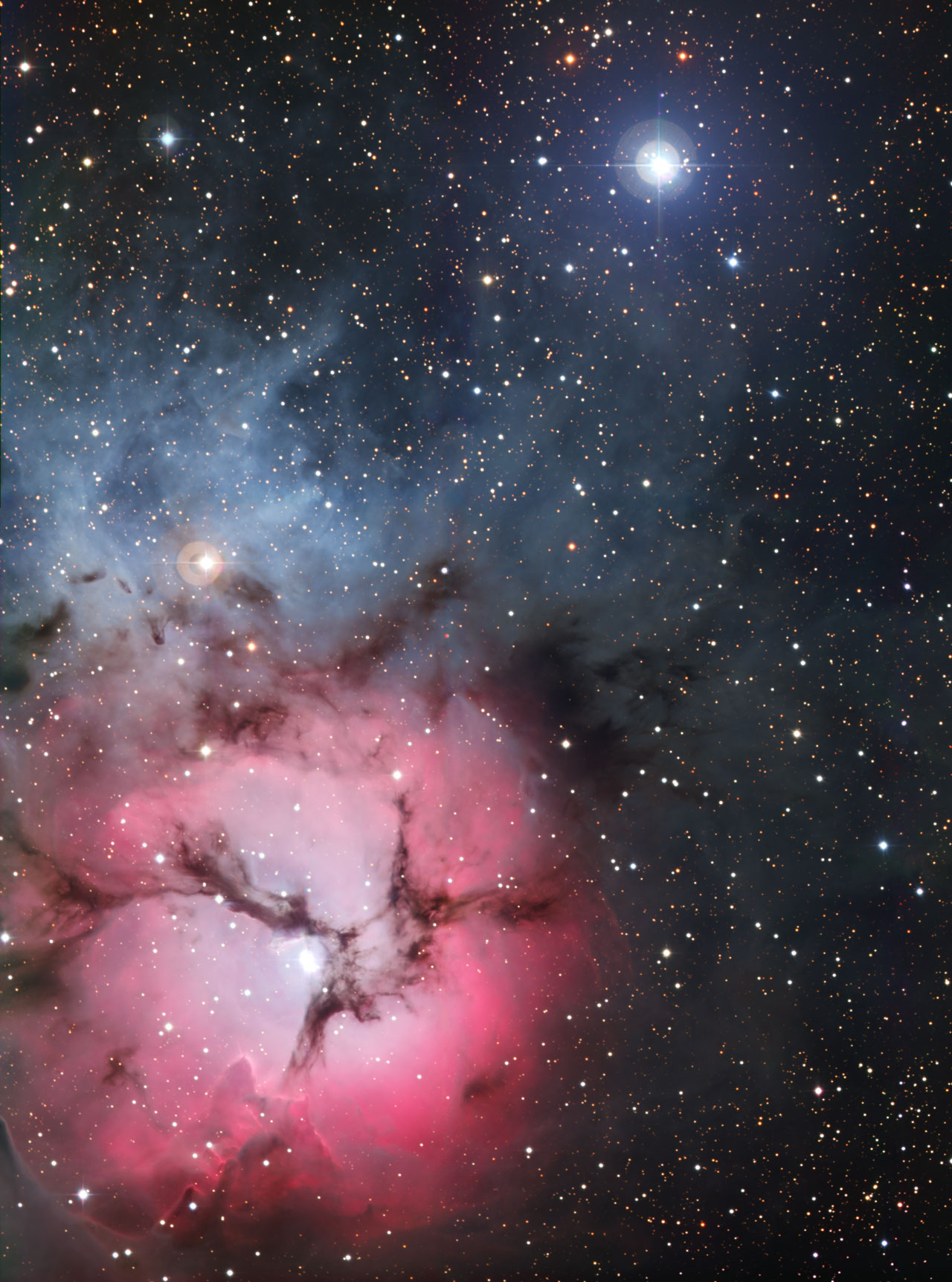
Emission nebulae are so named because their light is emitted by gas excited by the ultraviolet radiation from the young star. The gas, which is hot, is always rich in hydrogen, the most abundant element, and glows with a distinctive reddish-pink hue due the process of excitation of electrons in the atoms, similar to that of a neon light. Additional colours, such as blue and green, can be produced by the atoms of other elements, but hydrogen is almost always the most abundant. A good example of an emission nebula is the Orion Nebula. These nebula can also contain a lot of dust clouds that reflect the ultraviolet light of the nearby stars and are called “reflection nebulae”. They are usually blue in colour because the scattering is more efficient for ultraviolet light. In many cases, reflection and emission nebulae occur in the same area of star formation. For example, the red part of the Trifid Nebula is an emission nebula powered by the hot star in its centre. The blue part of the Trifid Nebula is a reflection nebula, reflecting light from a hot star centred in that part of the nebula. Thus, the Trifid Nebula is both an emission and reflection nebula.
As we have already seen, emission nebula are much like the neon lights you see on buildings and billboards. The lights use electricity to make the gas inside the bulb glow, while a diffuse nebula get its energy from the light of new stars within it. A reflection nebula is like fog around a street lamp and shines only because the light from an embedded source illuminates its dust; the nebula does not emit any visible light of its own.
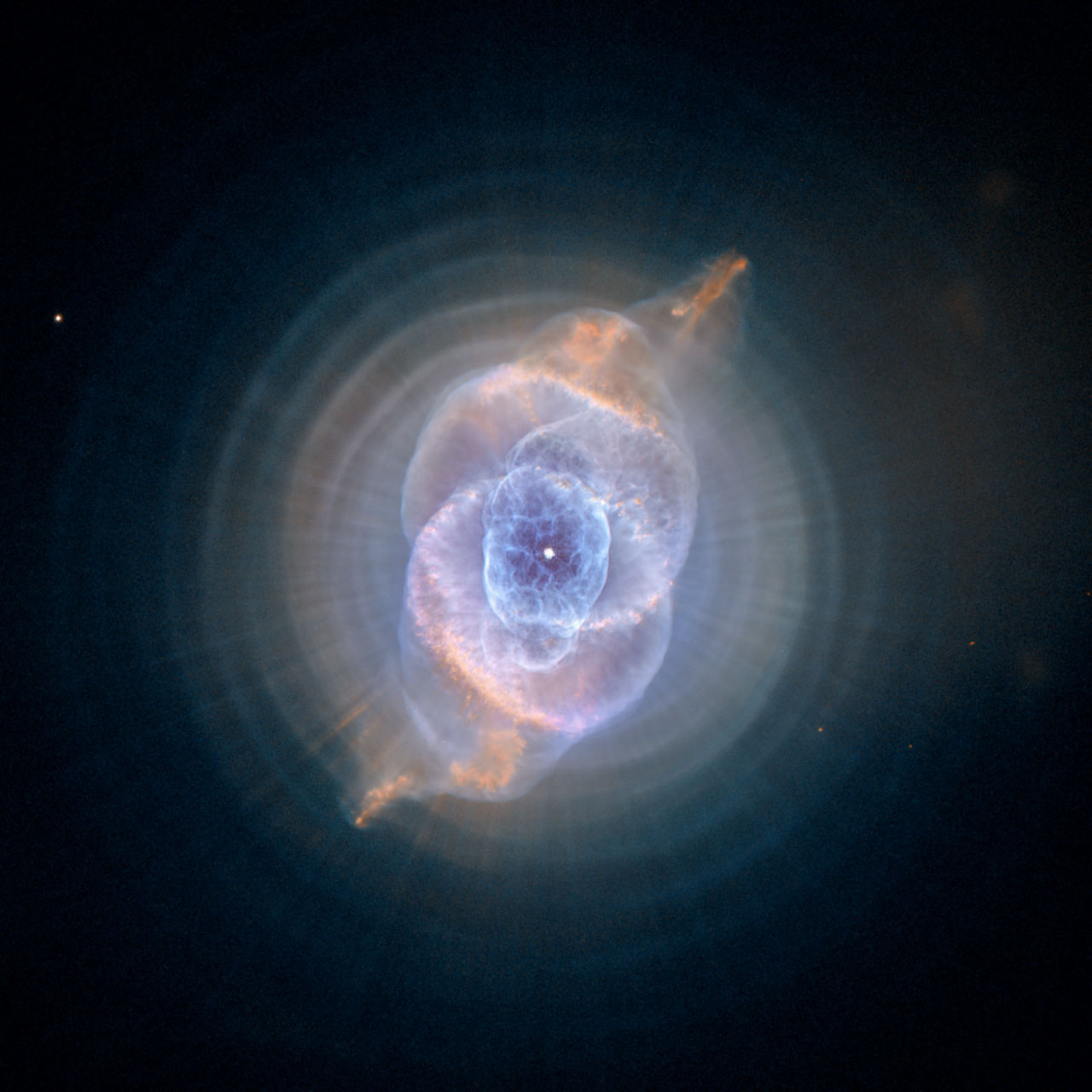
Another common type of emission nebula is a planetary nebula. Their name can be a bit misleading. They actually have nothing to do with planets. These nebulae were given this name because they often look like planets due to their round shape. A planetary nebula is created when a star blows off its outer layers after it has run out of fuel to burn. These outer layers of gas expand into space, forming a nebula which is often the shape of a ring or bubble, which is usually illuminated by the remains of the star at its centre. The Cat’s Eye Nebula in the northern constellation of Draco is one of the best examples of a planetary nebula.
PATTERNS
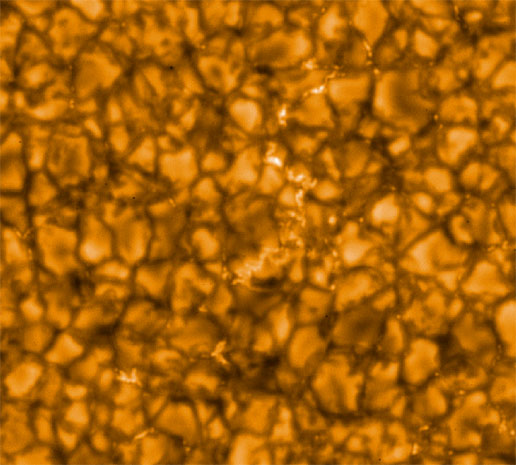
The surface of the Sun is blanketed by a patchwork of bright and dark patterns which changes and renews continually. Each bright granule is about 1000 kilometres across and is surrounded by an sinuous network of darker lanes. These are the trader signs of thermal convection, where hot plasma rises to the surface while cooler, denser plasma sinks. This surface convection is known as granulation and is readily observed with a moderate-sized telescopes with adaptive optics and looks very much lot like a pot of boiling water. Individual granules last for only about 20 minutes so the pattern of granulation is continually changing. Although they cannot be observed directly, researchers have long believed that larger scale convection cells lie deeper down, churning masses of plasma that are ten times larger than the diameter of the Earth. Using computer models scientists are now able to peer deeper into the inner workings of the Sun. The model can simulate convection patterns in the deep interior of the Sun in unprecedented detail. The giant cells play a critical role in solar variability and influence magnetic storms that can reach all the way to Earth.
Matter in the universe is not distributed randomly. Galaxies, quasars, and intergalactic gas organize themselves into filaments connected around enormous cosmic voids, with dense galaxy clusters forming where the walls intersect – a pattern that has been compared to soap bubbles. Scientists have many theories about how the universe evolved, and the theories predict different large-scale structures for the universe. Supercomputer simulations using more that 10 billion particles to trace the evolution of the matter in a cubic region of the Universe over 2 billion light-years on a side, are used to investigate how the distribution of matter in the Universe has evolved over time, in particular, how the observed population of galaxies was formed. Every point of light in the image shown represents a galaxy (blue) and galaxy clusters (orange) are formed when filaments of galaxies connect. By comparing such simulated data to large observational surveys, astronomers can clarify the physical processes underlying the build-up of galaxies and black holes.
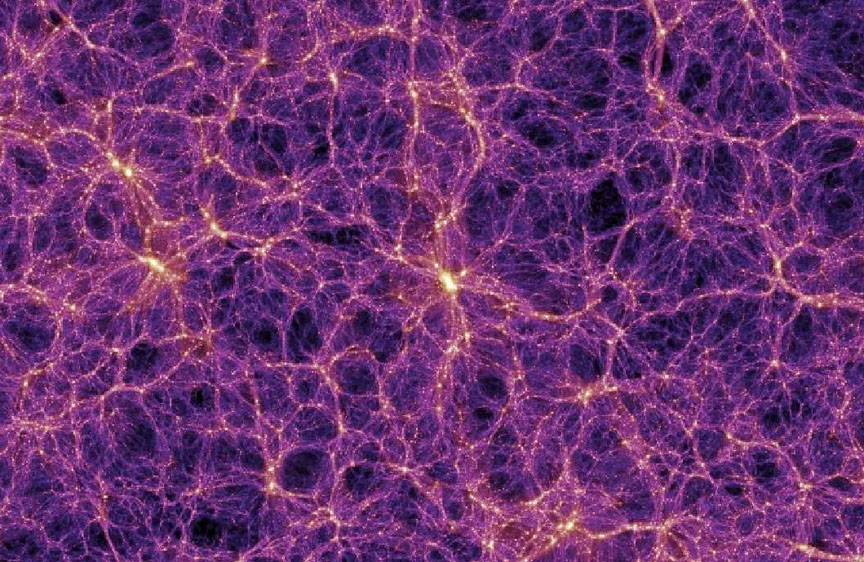
FORMS
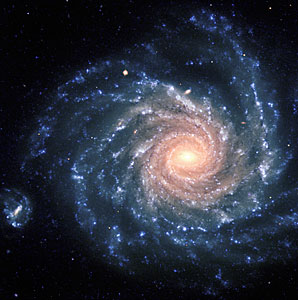
Everywhere we look in the sky there are galaxies of different shapes and sizes, nearly all galaxies have a supermassive black hole at the centre. Some are spirals, with curved arms wrapped around a bright central core. Some have a bar of stars across the centre, with arms attached at either end. Others have no recognizable shape at all. The largest galaxies look like squashed balls. Spiral galaxies are one of the most beautiful and familiar galaxy shapes. In fact when most people think of a galaxy, this type of galaxy shape is the first to come to mind. This is because the Milky Way is a prime example of a spiral galaxy. A spiral galaxy looks like a pinwheel where young stars are formed in the outer arms while older stars are found near the centre. A good example is Messier 100, a spiral galaxy which is located at a distance of 52.5 million light-years from the earth.
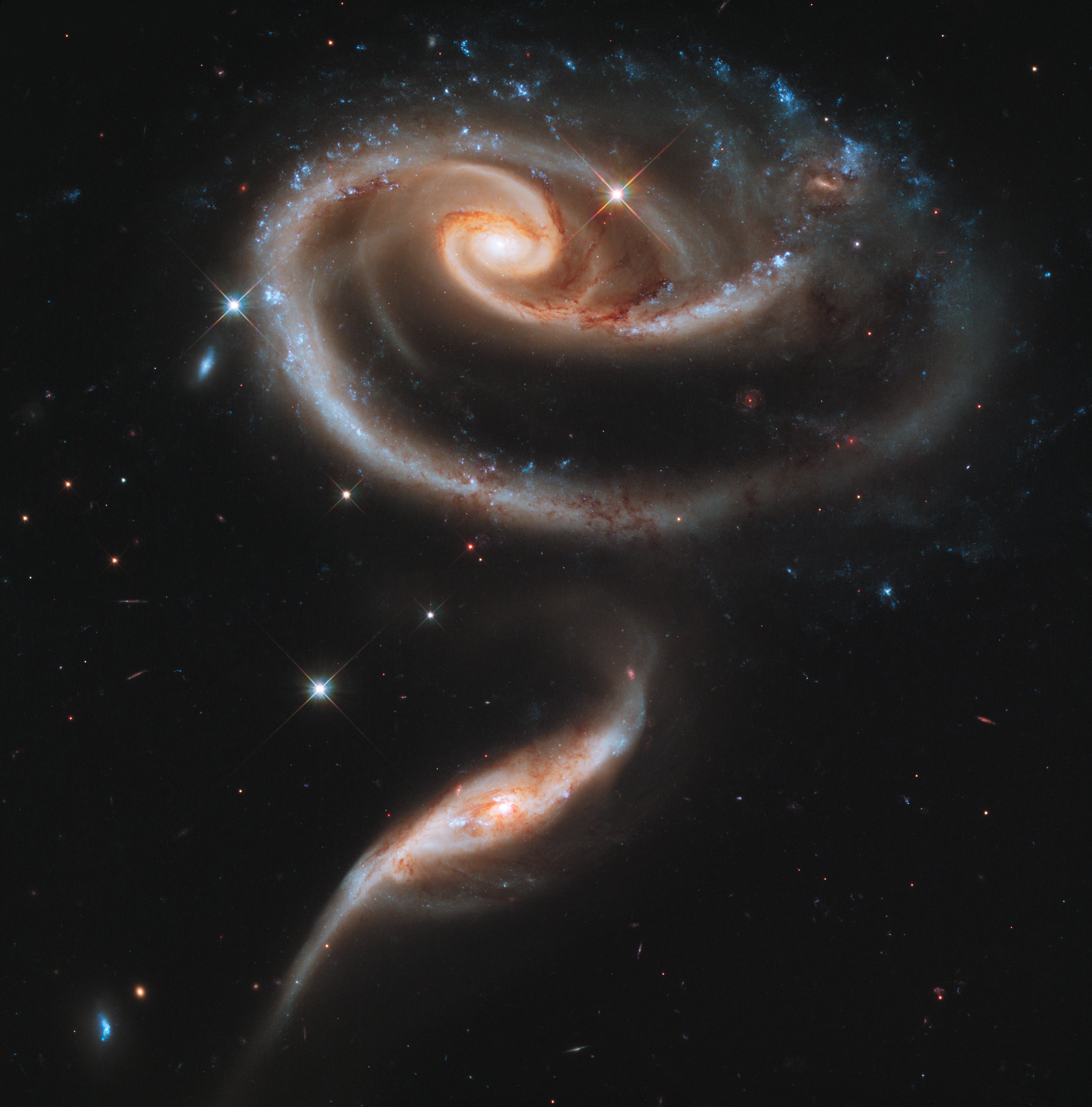
The larger of the spiral galaxies known as UGC 1810, has a disc that is tidally distorted into a rose-like shape by the gravitational pull of the companion galaxy below it, known as UGC 1813. The swathe of blue jewels across the top is the combined light from clusters of intensely bright and hot young blue stars. These massive stars glow fiercely in ultraviolet light. The smaller, nearly edge-on companion shows distinct signs of intense star formation at its nucleus, perhaps triggered by the encounter with the companion galaxy. Arp 273 lies in the constellation Andromeda and is roughly 300 million light-years away from Earth. The image shows a tenuous tidal bridge of material between the two galaxies that are separated by tens of thousands of light-years from each other.
Called the eXtreme Deep Field, the image was made by combining 10 years of NASA Hubble Space Telescope photographs with a total exposure time of two million seconds, of a very small patch of sky. It reveals 5,500 galaxies, making it the deepest image of the sky ever obtained and reveals the faintest and most distant galaxies ever seen, which allows us to explore further back in time than ever before. The faintest galaxies are one ten-billionth the brightness of what the human eye can see. The eye candy image is composite of ultraviolet (blue), optical (green) and infrared (red) observations. The ultraviolet is the strongest and arises from hot, star-forming regions ranging in distance between 5 and 10 billion light years. Magnificent spiral galaxies similar in shape to our Milky Way and the neighbouring Andromeda galaxy are also seen in this image, as do the large, fuzzy red galaxies where the formation of new stars has ceased. These red galaxies are the remnants of dramatic collisions between galaxies and are in their declining years.
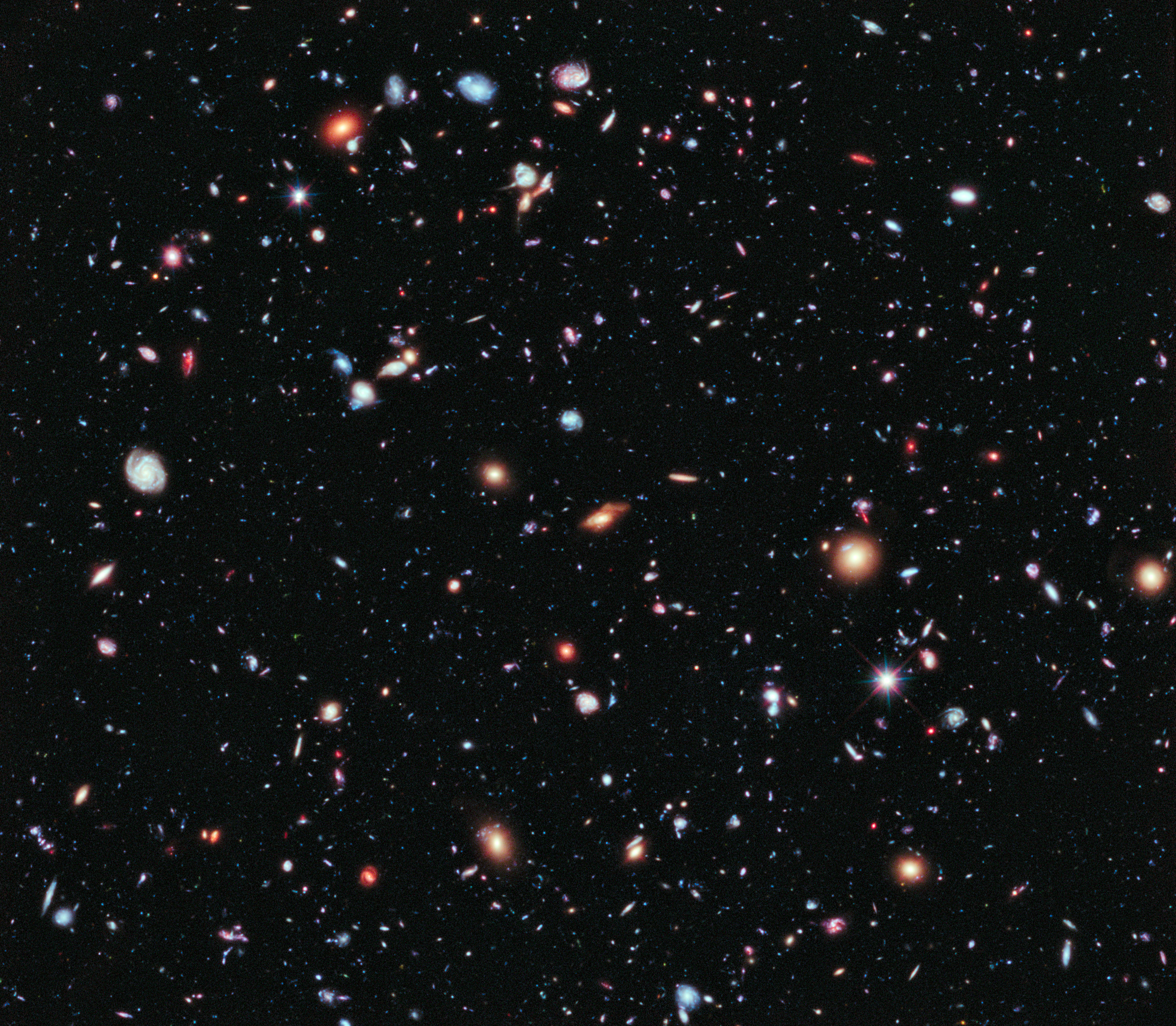
STRUCTURE
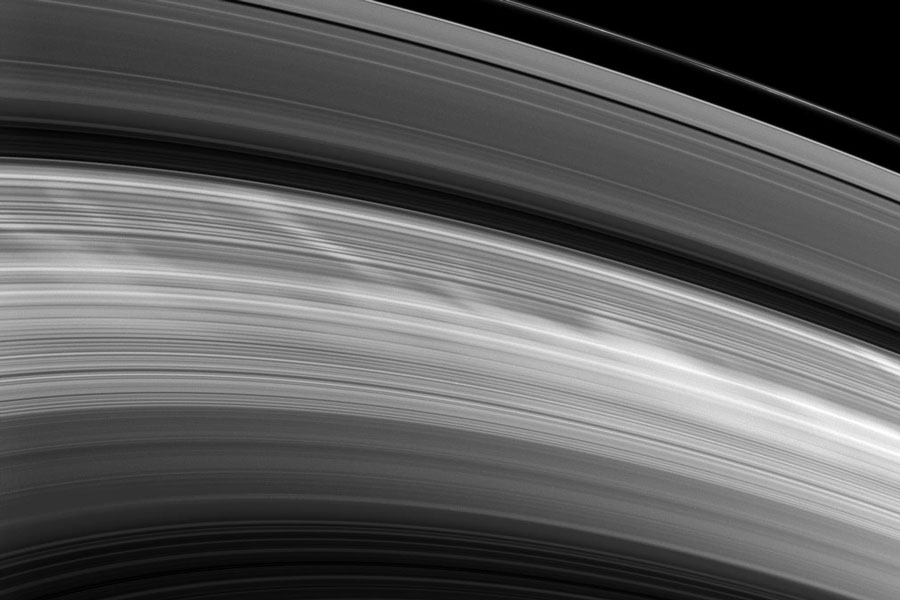
Saturn, the sixth planet from the sun and is one of the most easily identified targets for astronomers, largely due to its large and distinct
ring system. The rings of Saturn have fascinated stargazers for centuries, ever since telescopes were built. Saturn’s rings are made of billions of pieces of ice, dust and rocks. Some of these particles are as small as a grain of salt, while others are as big as houses. These chucks of rock and ice are thought to be pieces of comets, asteroids or even moons which were torn apart by the strong gravity of Saturn before they could reach the planet. Though Saturn appears surrounded by a single, solid ring when viewed by an amateur astronomer, several divisions exist.

Closer to home we have the Moon. Topographically, unlike the Earth the Moon is very different. The Moon’s surface is characterized by highlands and lowlands, mountains, and most notably, craters. These craters are often marked by secondary craters and by rays from matter ejected from meteor impacts. The first thing that you’ll notice when you look at the moon’s surface are the dark and light areas. The dark areas are called maria and are lava-filled basins up to 1000 kilometres in diameter formed by ancient volcanic eruptions. The maria cover about 16% of the lunar surface, mostly on the near-side visible from Earth. The remainder of the lunar surface consists of rough, mountainous, heavily cratered regions.
THE LINK
Fashion Astronomy and are not so far from each other. Both disciplines not only make use of the same observation, reflection and imagination, but share the passion for beauty. The link between astronomy and fashion can seen in the event organized by the IAC “Wear the stars” which consisted of a fashion show inspired by the Astronomy and the Cosmos. In the photographs taken during the event you can see the astronomical inspiration behind the designs.
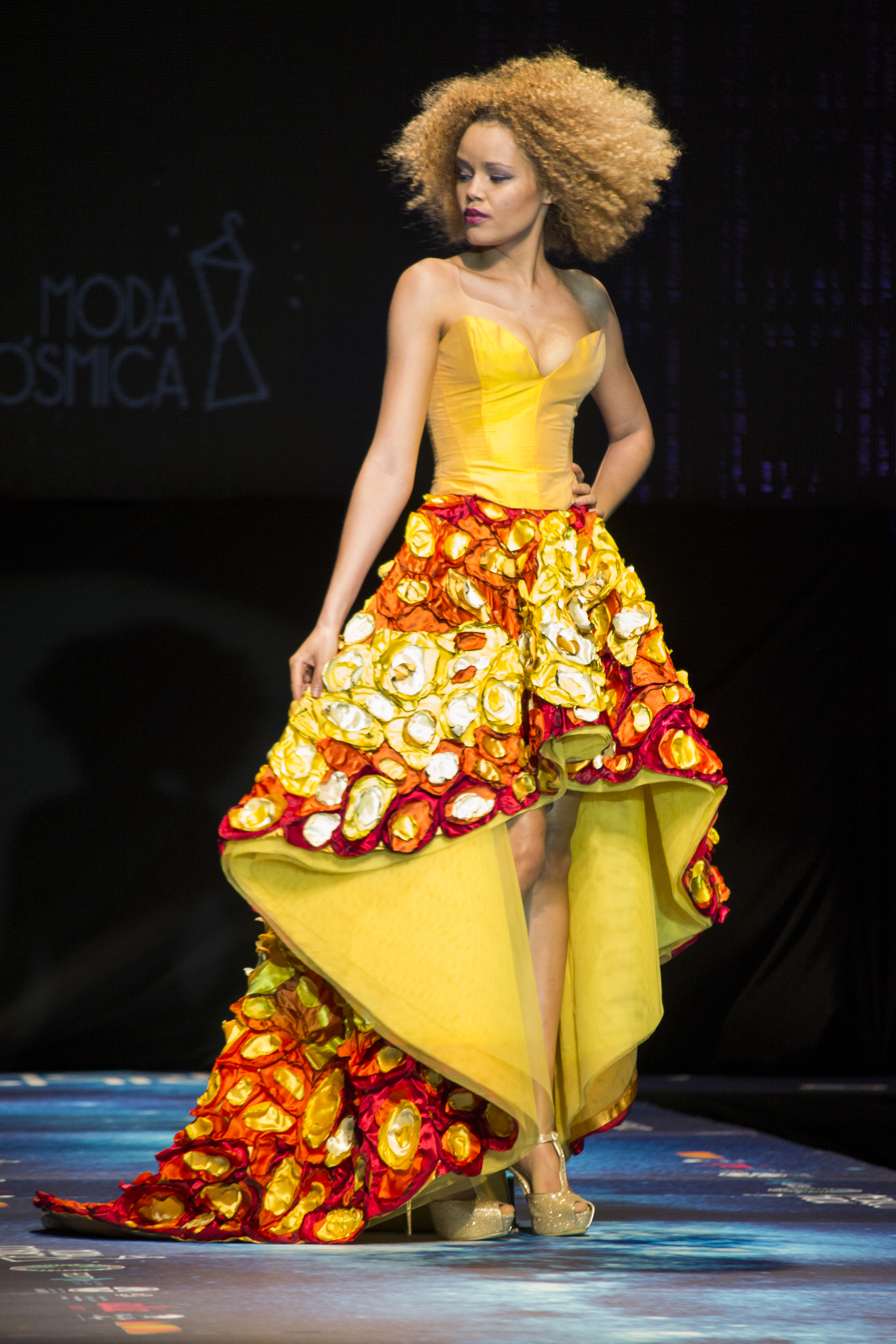
Sounds
In space, there is no sound but there is plenty of light. And although we often think of space as eternal and unchanging, many objects in space emit light that changes rapidly and dramatically in intensity. By using the technique of sonification, we can represent the changing light from space as sound waves. We can measure the brightness of the object in any part of the electromagnetic spectrum, from radio frequencies to X-rays and create sounds in which the volume goes up and down in proportion to the luminosity of the object. However, there is just one complicatio, the human ear can only perceive sounds whose amplitude changes over a very narrow range of frequencies. For example in the musical note A4, the sounds amplitude changes very quickly; at around 440 times a second (440 Hz). Only rarely does the cosmos provide objects which that happen to vary at the right frequency to provide audible sounds. Therefore, to produce the sounds the brightness changes are converted to changes in volume, but the rate at which the light changes is shifted to make the resulting sounds fall into the range we can hear. The data we have sonified are from various astronomical objects, including the Sun, pulsating stars, pulsars, binary systems, white dwarfs, neutron stars and black holes, which have been obtained using various NASA’s space satellites as well as ground based telescopes. We have created a database of samples and loops in which several weeks’ worth of measurements of an object have been compressed into a few seconds. The music to accompany the different sections of the event is primarily composed of these samples.
The sounds were created by Tariq Shahbaz of the Instituto de Astrofísica de Canarias and the music was produced by BillyFlux TRIPCODE.
Competition
“Wear the stars” is a drawing competition created by the Instituto de Astrofisica de Canarias (IAC) with the aim of attracting the young generation to science and technology, linking astronomy with fashion.
From now until May 25, 2015, if you are between 12 and 16 years old you can participate in this fun and informative drawing competition.
Make a sketch on a piece of paper (A4 size) using any technique you want (paintings, watercolors, crayons, etc.) in which the concepts “Astronomy and Fashion” are present. Once completed, you must scan the image with your name and send the graphic file in JPG, PNG or PDF format via the web form, which can be found below on this same page.
The winners will be announced on June 1, 2015. There will be two winners who will each receive a garment with designs made by the School of Art and Design (SAD) “Fernando Estévez”. In addition, the garments will be presented during the event.
The competition is organized by the IAC and SAD “Fernando Estévez”, the Ministry of Education, Universities and Sustainability of the Canary Islands with funding from the Spanish Foundation for Science and Technology – Ministry of Economy and Finance.
Judges
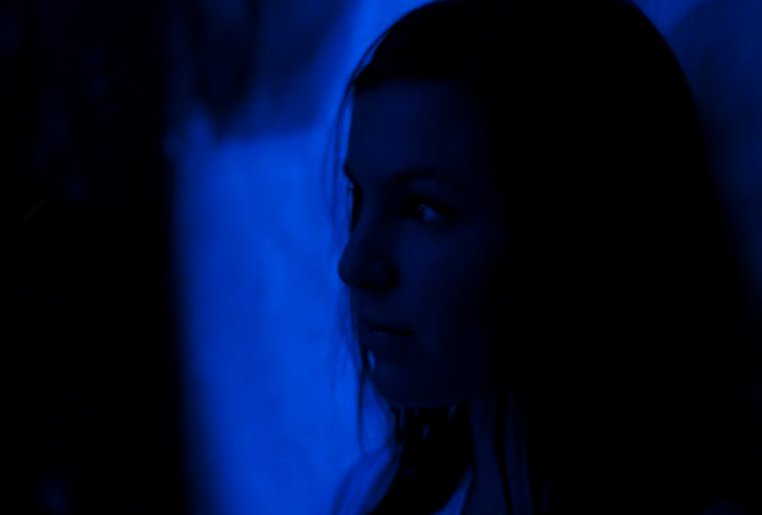 |
Tamara Ruiz, was born in Seville and has always felt a passion for Fashion as well as for Astronomy. First, she studied Aeronautical Engineering at the Polytechnic University of Madrid, taking introductory courses in Astronomy and amateur observations with her own telescope. Later, Tamara graduated in Fashion Design and has a special interest in the application of technology to fashion. Currently she is a professional designer and plans to continue her training in the area of technological innovation applied to textile products. |
 |
Laura del Puerto is a young designer from the Canary Islands who decided to enter the world of fashion after studying two years of Fine Arts at the University of La Laguna. She did this by moving to Madrid to study at the School of Fashion Design of the Polytechnic University of Madrid. She has worked in the department of tricot of Blanco Suite and currently leads the product management of eCommerce at Adolfo Dominguez. |
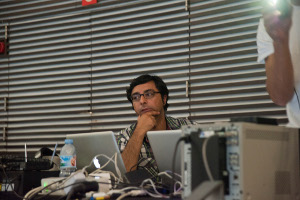 |
Tariq Shahbaz was born in Manchester, England. He arrived in Tenerife in 2000 and is a staff member of the Instituto de Astrofísica de Canarias, specialising in the studies of compact objects, such as black holes and neutron stars. He has obtained and lead various projects financed by the MINECO and has been a member of various international scientific committees. In 2012 he produced and directed the multimedia event linking contemporary dance with Astronomy “La viuda negra, canibalismo cósmico“, financed by the FECYT. |
 |
Carmen Del Puerto Varela. Journalist specializing in science and technology with a doctorate in Information Science. For six years she was director of the Museum of Science and the Cosmos of the Town Council of Tenerife. In 2010 she wrote and directed the play “The lost honor of Henrietta Leavitt,” a tribute to the role of women in astronomy, funded by the FECYT. She is currently head of the Communication and Scientific Culture (UC3) of the IAC. |
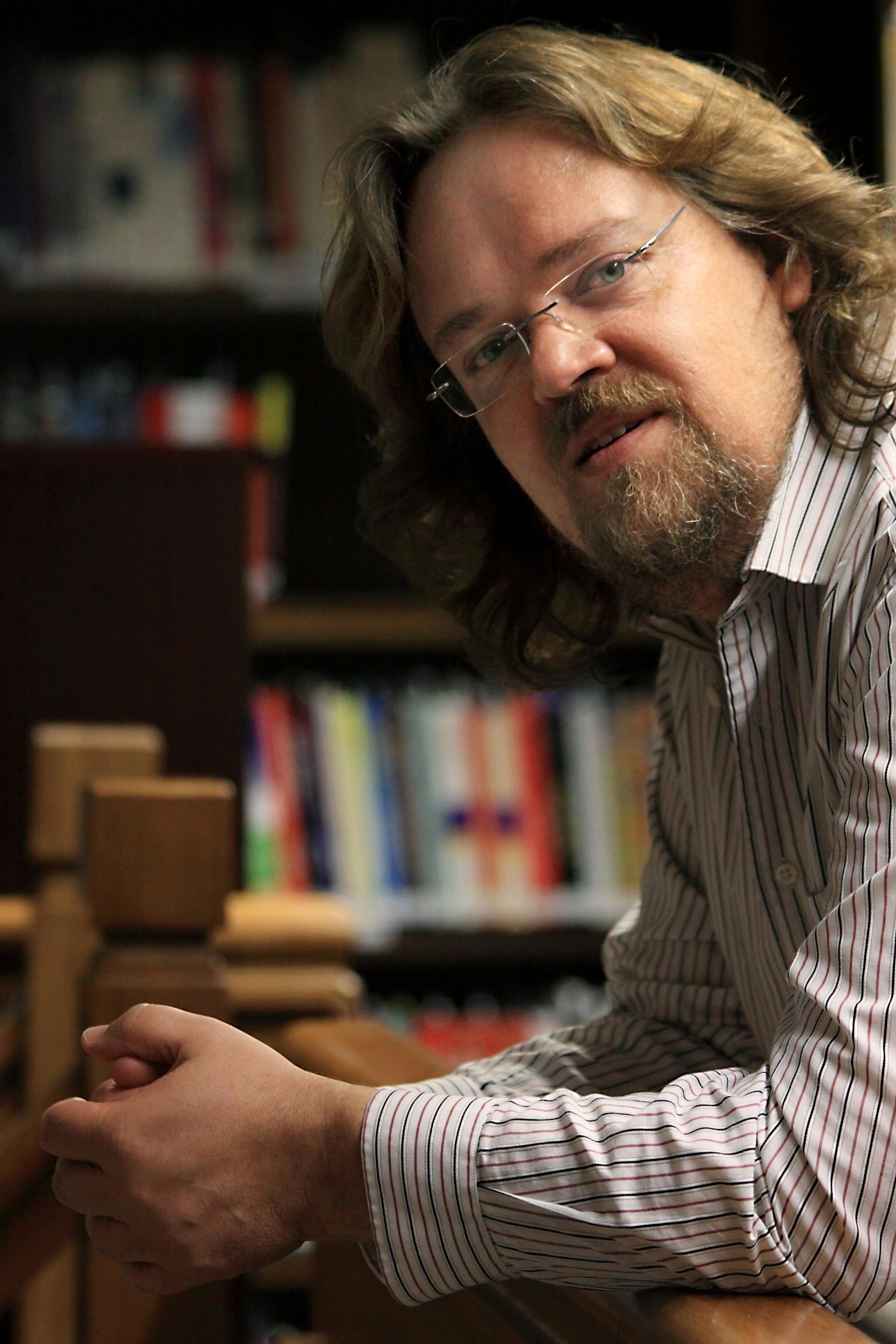 |
Alfred Rosenberg González is an astrophysicist-communicator of the Instituto de Astrofísica de Canarias (IAC). He completed his undergraduate studies at the University of La Laguna and has a doctorate from the Astronomical Osservatorio di Padova, Italy. Currently he is a member of the Communication and Scientific Culture (UC3) of the IAC. |
 |
Humberto Chávez. Graduate with a degree in Fine Arts from the University of La Laguna and specializing in Sculptural Restoration (from the University of Granada). Professor of Plastic Arts at the School of Art and Design Fernando Estévez. |
Members
Results
Press release:
Cosmic Fashion. Fashion show: https://www.iac.es/es/divulgacion/noticias/moda-cosmicadesfile
Pasarela sobre la Vía Láctea (only in Spanish): https://www.iac.es/es/divulgacion/noticias/pasarela-sobre-la-lactea
